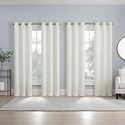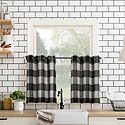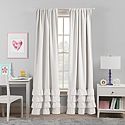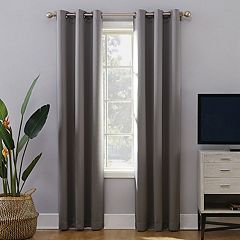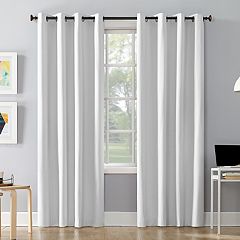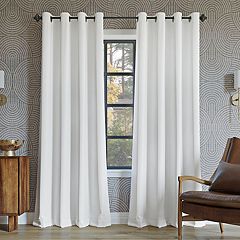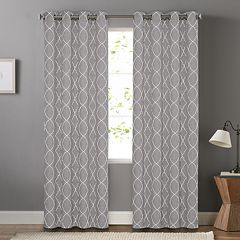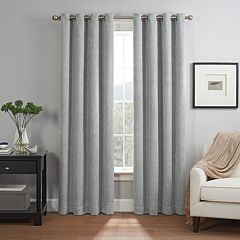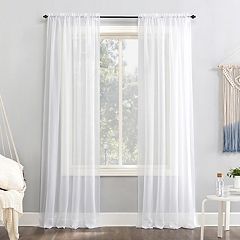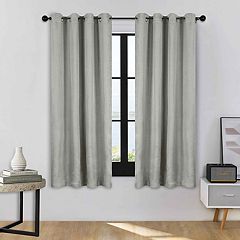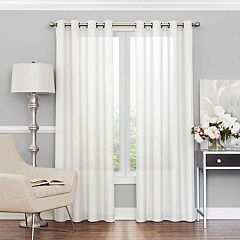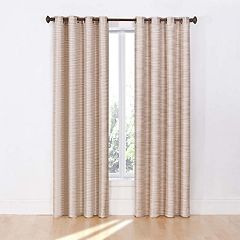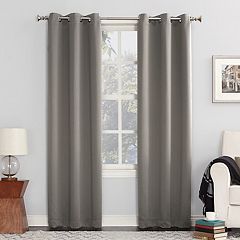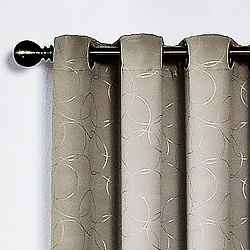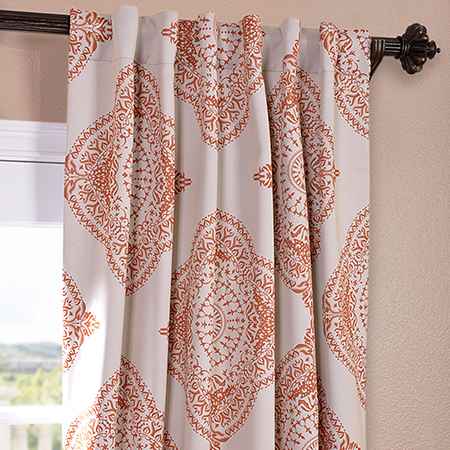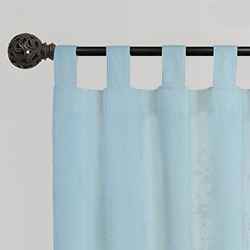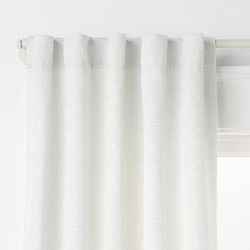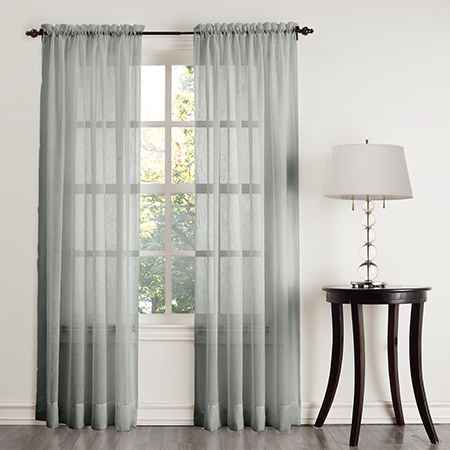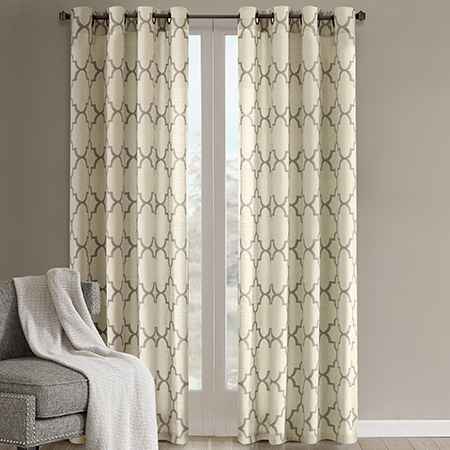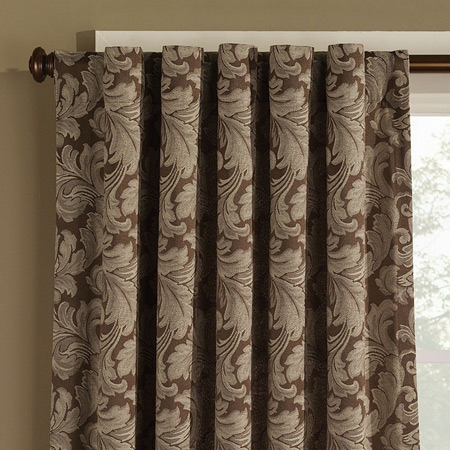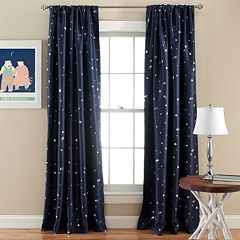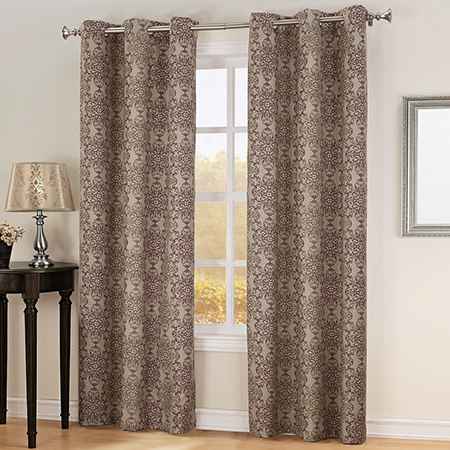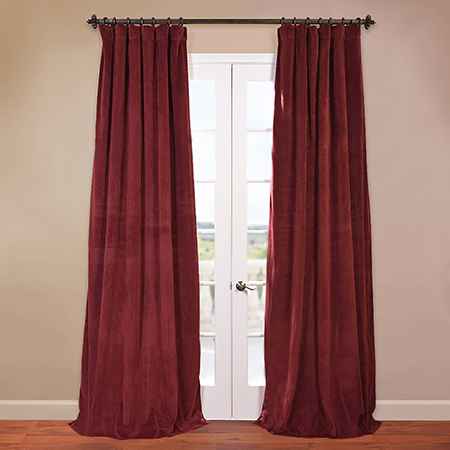Curtains and Drapes
-
$13.59 - $79.04 with code SAVINGS15
 $15.99 - $92.99 $39.99 - $92.99 Reg.
$15.99 - $92.99 $39.99 - $92.99 Reg.Sun Zero 2-Pack 100% Blackout Theater Grade Norway Grommet Curtain
-
$16.99 - $25.49 with code SAVINGS15
 $19.99 - $29.99 Reg.
$19.99 - $29.99 Reg.Sun Zero Cameron 100% Blackout Thermal Insulated Grommet Single Curtain Panel
-
$33.99 - $106.24 with code SAVINGS15
 $39.99 - $124.99 $99.99 - $124.99 Reg.
$39.99 - $124.99 $99.99 - $124.99 Reg.Sonoma Goods For Life® 2-pack Dynasty Blackout Curtain
-
$12.74 - $21.24 with code SAVINGS15
 $14.99 - $24.99 Reg.
$14.99 - $24.99 Reg.Sun Zero Gramercy Room Darkening Rod Pocket Curtain Panel
-
$25.49 - $61.19 with code SAVINGS15
 $29.99 - $71.99 Reg.
$29.99 - $71.99 Reg.Sun Zero Oslo 100% Blackout Theater Grade Solid Grommet Single Curtain Panel
-
$23.79 - $46.74 with code SAVINGS15
 $27.99 - $54.99 $39.99 - $69.99 Reg.
$27.99 - $54.99 $39.99 - $69.99 Reg.Sun Zero 2-Pack 100% Blackout Theater Grade Solita Botanical Curtain
-
$33.99 - $106.24 with code SAVINGS15
 $39.99 - $124.99 $99.99 - $124.99 Reg.
$39.99 - $124.99 $99.99 - $124.99 Reg.Sonoma Goods For Life® 2-pack Embroidered Dynasty Blackout Curtain
-
$12.74 - $21.24 with code SAVINGS15
 $14.99 - $24.99 Reg.
$14.99 - $24.99 Reg.eclipse Kids Kendall Single Curtain Blackout 1-Panel Window Curtain
-
$12.74 - $25.49 with code SAVINGS15
 $14.99 - $29.99 Reg.
$14.99 - $29.99 Reg.Sun Zero Mercer Blackout Solid Grommet Single Curtain Panel
-
$21.24 - $50.99 with code SAVINGS15
 $24.99 - $59.99 Reg.
$24.99 - $59.99 Reg.SUPERIOR Leaves Insulated Thermal 2-Pack Blackout Grommet Window Curtain Panels
-
$16.99 - $21.24 with code SAVINGS15
 $19.99 - $24.99 Reg.
$19.99 - $24.99 Reg.Sun Zero Cyrus Thermal 100% Blackout Back Tab Window Curtain
-
$16.99 - $61.19 with code SAVINGS15
 $19.99 - $71.99 $49.99 - $71.99 Reg.
$19.99 - $71.99 $49.99 - $71.99 Reg.The Big One® 2-pack Raiden Solid Grommet Decorative Window Curtain Set
-
$25.49 - $67.99 with code SAVINGS15
 $29.99 - $79.99 Reg.
$29.99 - $79.99 Reg.SUPERIOR Solid Insulated Thermal 2-Piece Blackout Grommet Window Curtain Panels
-
$110.49 - $144.49 with code SAVINGS15
 $129.99 - $169.99 Reg.
$129.99 - $169.99 Reg.eclipse 2-Pack Absolute Zero Dean 100% Blackout Curtains
-
$47.59 - $165.74 with code SAVINGS15
 $55.99 - $194.99 $139.99 - $194.99 Reg.
$55.99 - $194.99 $139.99 - $194.99 Reg.Sonoma Goods For Life® Ultimate Performance Woven Geo 2-pack 100% Blackout Curtain
-
$8.49 - $16.99 with code SAVINGS15
 $9.99 - $19.99 Reg.
$9.99 - $19.99 Reg.No. 918 Emily Solid Sheer Voile Rod Pocket Single Window Curtain Panel
-
$47.59 - $165.74 with code SAVINGS15
 $55.99 - $194.99 $139.99 - $194.99 Reg.
$55.99 - $194.99 $139.99 - $194.99 Reg.Sonoma Goods For Life® Ultimate Performance 2-Pack Lindley Embroidered 100% Blackout Curtain
-
$16.99 - $21.24 with code SAVINGS15
 $19.99 - $24.99 Reg.
$19.99 - $24.99 Reg.Sun Zero 1-Panel Gramercy Grommet Room Darkening Window Curtain
-
$23.79 - $76.49 with code SAVINGS15
 $27.99 - $89.99 $64.99 - $89.99 Reg.
$27.99 - $89.99 $64.99 - $89.99 Reg.Sun Zero 2-Pack Laurent 100% Blackout Boucle Texture Rod Pocket Window Curtain
-
$25.49 - $46.74 with code SAVINGS15
 $29.99 - $54.99 Reg.
$29.99 - $54.99 Reg.SUPERIOR Faux Linen Insulated Thermal Blackout Set of 2 Window Curtain Panels
-
$12.74 - $16.99 with code SAVINGS15
 $14.99 - $19.99 Reg.
$14.99 - $19.99 Reg.No. 918 Sora Casual Textured Semi-Sheer Grommet Window Curtain
-
$12.74 - $16.99 with code SAVINGS15
 $14.99 - $19.99 Reg.
$14.99 - $19.99 Reg.No. 918 Erica Crushed Sheer Voile Window Curtain
-
$16.99 - $25.49 with code SAVINGS15
 $19.99 - $29.99 Reg.
$19.99 - $29.99 Reg.eclipse Liberty Uv Light-Filtering Sheer 1-Panel Window Curtain
-
$44.19 - $118.99 with code SAVINGS15
 $51.99 - $139.99 $69.99 - $139.99 Reg.
$51.99 - $139.99 $69.99 - $139.99 Reg.eclipse Dylan 2-Pack Blackout Curtains
-
$21.24 - $25.49 with code SAVINGS15
 $24.99 - $29.99 Reg.
$24.99 - $29.99 Reg.Sun Zero Valencia Indoor/Outdoor Fade Resistant Cabana Stripe Grommet Curtain Panel
-
$21.24 - $25.49 with code SAVINGS15
 $24.99 - $29.99 Reg.
$24.99 - $29.99 Reg.Sun Zero Sailor Indoor/Outdoor Fade Resistant + UV Protectant Curtain Panel
-
$44.19 - $152.99 with code SAVINGS15
 $51.99 - $179.99 $129.99 - $179.99 Reg.
$51.99 - $179.99 $129.99 - $179.99 Reg.eclipse 2-panel Absolute Zero Draft Stopper Brighton 100% Blackout Curtain Set
-
$13.59 - $52.69 with code SAVINGS15
 $15.99 - $61.99 $39.99 - $61.99 Reg.
$15.99 - $61.99 $39.99 - $61.99 Reg.Sonoma Goods For Life® 2-pack Leaf Embroidered Window Curtain
-
$29.74 - $42.49 with code SAVINGS15
 $34.99 - $49.99 Reg.
$34.99 - $49.99 Reg.Archaeo Washed Cotton Semi-Sheer Twist Tab Single Curtain Panel
-
$12.74 - $16.99 with code SAVINGS15
 $14.99 - $19.99 Reg.
$14.99 - $19.99 Reg.No. 918 Emily Sheer Voile Grommet Single Curtain Panel
-
$16.99 - $29.74 with code SAVINGS15
 $19.99 - $34.99 Reg.
$19.99 - $34.99 Reg.Sun Zero 1-Panel Ludlow Blackout Grommet Window Curtain
-
$12.74 - $16.99 with code SAVINGS15
 $14.99 - $19.99 Reg.
$14.99 - $19.99 Reg.eclipse 2-Pack Victoria Voile Window Curtains
-
$21.24 - $33.99 with code SAVINGS15
 $24.99 - $39.99 Reg.
$24.99 - $39.99 Reg.Window Curtainworks 1-Panel Kendall Lined Window Curtain
-
$38.24 - $67.99 with code SAVINGS15
 $44.99 - $79.99 Reg.
$44.99 - $79.99 Reg.Exclusive Home 2-pack Sateen Twill Woven Blackout Window Curtains
-
$40.79 - $123.24 with code SAVINGS15
 $47.99 - $144.99 $119.99 - $144.99 Reg.
$47.99 - $144.99 $119.99 - $144.99 Reg.Sonoma Goods For Life® 2-pack Jacquard Woven Leaf Blackout Curtain
-
$16.99 with code SAVINGS15
 $19.99 Reg.
$19.99 Reg.No. 918 Sora Print Textured Semi-Sheer Grommet Single Curtain Panel
-
$12.74 - $25.49 with code SAVINGS15
 $14.99 - $29.99 Reg.
$14.99 - $29.99 Reg.No. 918 Lourdes Crushed Sheer Rod Pocket Single Curtain Panel
-
$16.99 - $21.24 with code SAVINGS15
 $19.99 - $24.99 Reg.
$19.99 - $24.99 Reg.Sun Zero Cyrus Thermal 100% Blackout Grommet Window Curtain
-
$25.49 - $33.99 with code SAVINGS15
 $29.99 - $39.99 Reg.
$29.99 - $39.99 Reg.Madison Park Vera 1-Panel Burnout Lightweight Semi-Sheer Grommet Window Curtain
-
$13.59 - $52.69 with code SAVINGS15
 $15.99 - $61.99 $29.99 - $61.99 Reg.
$15.99 - $61.99 $29.99 - $61.99 Reg.Sonoma Goods For Life® 2-pack Fret Embroidery Window Curtains
-
$38.24 with code SAVINGS15
 $44.99 Reg.
$44.99 Reg.The Big One® Kentfield Grommet Sliding Patio Door Curtain Panel
How to Hang Curtains
You may think knowing how to hang curtains is fairly intuitive – get curtains, put on curtain rod, done – but there's a lot to be done before you get to that point. You have choices to make, styles to consider, window dimensions to keep in mind and more.
With our curtain hanging guide, you can learn how to measure your windows, select the right window hardware and how to hang curtains that fit your overall style and design aesthetic. Discover all the window treatments and décor available at Kohl's.
Step #1 How to Measure Windows
All curtain-hanging decisions hinge on the windows you're planning to hang the curtains over. So before you can begin the fun stuff of shopping, you need to know how to measure windows to ensure your curtains will get the job done.
Measuring the Width
To ensure accuracy, measure the width of your window in three places: the top, the middle and the bottom. If you were hanging blinds or other inside-mount window treatments, you'd use the smallest width measurement as your guide. For outside mounts, like curtains, however you instead want to consider how far you'd like the window treatment to extend.
Keep in mind that hardware usually adds two and a half inches to each side of your window for a total of five extra inches. To create the illusion of a wider window, add three to six inches on either side of the window frame.
Measuring the Height
Next, measure the height of your window. If you're hanging kitchen curtains or other smaller curtains, you'll measure from the bottom of your window sill or just below it to the top of your window. For full-length curtains in a living room, measure instead from the floor to the top of your window. To make your room appear taller, add an extra four to six inches to the top of the window.
Use your pencil to mark how high you'd like your curtains to hang. Once you have your measurements for both the height and width, round up to the nearest standard panel size.
Step #2. Choosing Window Hardware
With the measurements done, now you can start making style choices. Before you can choose the curtains however, you need to have curtain rods to hang them on.
If you already have the curtain rod of your dreams, you can skip this section, but if you're looking to upgrade your window hardware (or have none to begin with) consider some of these design styles. Finials come in a variety of designs, making it easy to find a curtain rod that fits your decorating theme. Matching holdbacks and clip rings will complete your polished look.
Step #3. Choosing Curtains
Now comes the fun part, finding out how to hang curtains that fit your personal sense of style and design aesthetic – that means choosing two things: window top treatments and curtain fabrics.
Window Top Treatments
A top treatment is how a curtain fastens to the rod(s) above your window. Choose a top treatment that suits the formality of your space and the hardware you select.
Metal Openings at the top of each panel create a crisp and contemporary look. | A built-in pocket at the top of each panel slips onto the rod for a casual, gathered look. | Single loops of fabric at the top of each panel are best for casual, relaxed rooms. | Like a rod pocket, this classic style slips directly onto the rod for a formal look. Thick, gathered pleats complement traditional decor. | Loops of fabric on the backs of the panels create the illusion of floating and provide a clean, tailored look. |
How to Choose Curtain Fabric
Curtains are available in nearly every fabric type, from light and sheer to heavy and thick, ideal for a number of different window treatment ideas.
Sheer Fabric Curtains These lightweight curtains complement decor without overwhelming it. They allow light to shine through, giving your room an airy feel. Pair with a heavyweight curtain to achieve a layered look. | Medium-Weight Fabric Curtains Fabrics like cotton provide moderate levels of light filtration. To maintain privacy while still letting outside light in, choose curtains in this category. | Heavy-Weight Fabric Curtains Velvet and other heavy-weight fabrics deliver a formal look. These curtains are perfect for providing extra privacy and insulation. |
Back-Tab Curtains Loops of fabric on the backs of the panels create the illusion of floating and provide a clean, tailored look. | Thermal Curtains The thermal backing on these curtains works year round. In the summer, the curtains keep cool air in your home and hot air outside or vice versa. | Blackout Curtains These heavy-duty blackout curtains not only block out light, but also create a sound barrier to protect against outside noises. |
Layered Window Treatments
Pairing sheer panels, curtains, shades, blinds or valances together creates a completed look, while also providing additional privacy and light filtration. The versatility of this style gives you several possibilities. Using a double curtain rod, you can layer sheers or valances and heavier curtains over blinds or shades, or you can use a single curtain rod to layer your choice of panels over blinds or shades. Depending on your fabric and hardware choices, layering can be simple and casual or embellished and formal.
- Curtains: Choose a curtain to either complement your current colors or make a bold statement.
- Sheers: Choose sheer panels to allow light to softly filter into your room. For maximum light blocking, pair a patterned sheer window panel with a solid curtain to create the desired effect.
- Blinds & Shades: Enjoy privacy when you want it with blinds or shades. They also create a tailored look.
- Hardware: Use hardware that coordinates with your decor. Double curtain rods allow you to layer sheer and heavy-weight window panels.


